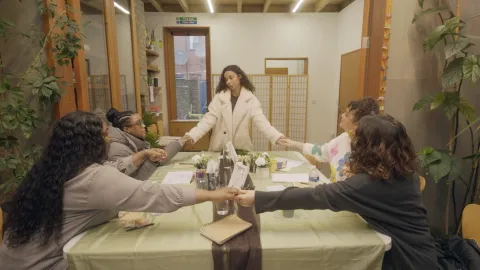JENNY MITCHELL, poetry co-editor for the Morning Star, introduces her priorities, and her first selection
SYLVIA HIKINS casts an eye across the contemporary art brought to a city founded on colonialism and empire

 COMPASSIONATE / VISIONARY / IRONIC: Odur Ronald, Muly'Ato Limu - All in One Boat, 2025, Liverpool Biennial 2025 [Pic: Mark McNulty]
COMPASSIONATE / VISIONARY / IRONIC: Odur Ronald, Muly'Ato Limu - All in One Boat, 2025, Liverpool Biennial 2025 [Pic: Mark McNulty]
IT’s Biennial time again in Liverpool, Britain’s largest free festival of contemporary works of art, as always, linked to a specific theme related to the city.
This year it’s Bedrock, a concept inspired by the mass of sandstone that runs under the city, holding up the loose soil above. Bedrock is also a metaphor for the principles and ideas that form social foundations.
Curated by Marie-Anne McQuay, 30 international artists bring together their own interpretation of Bedrock, including colonialism and empire, major elements in Liverpool’s past growth and expansion. At the edge of the river and still functioning, the Old Dock is made from local stone, evidence of where geology and empire fused.
What better place to start my tour of the event than in the Liverpool Anglican Cathedral, an iconic building constructed from locally quarried red sandstone.
There’s Where Am I Now (★★★★), a fascinating exhibit from Cypriot artist Maria Loizidou. Using a common, traditional weaving technique, this large-scale installation features hand-embroidered migratory birds native to Liverpool and is a reflection on migration, co-existence and survival in our increasingly hostile world.
In another iconic Liverpool building, The Walker Art Gallery, nine artists have exhibits, including Jennifer Tee (★★★★), a Dutch artist whose work explores cultural memory, personal heritage, global histories of migration and exchange. Here we see a selection of her collages that, using dried tulip petals, highlight the delicate fleeting nature of life.
One fascinating aspect of the Biennial is the different forms taken to convey messages. At the Open Eye Gallery, close to the waterfront, three artists use lens-based media to explore themes relating to exploitation, myths and lost traditions, including a film by Katarzyna Perlak (★★★★) set in Liverpool’s iconic Adelphi Hotel.

On show at the Bluecoat Gallery is Liverpool-born artist, Amber Akaunu’s film, Dear Othermother (★★★★★), that features the network of mothers in Toxteth, one of the oldest black communities in Britain, and focuses on the way society has constructed the concept of “chosen family.”
Although not built from bedrock, the Bluecoat was originally a school funded by Bryan Blundell, former Liverpool merchant, mayor and philanthropist whose fortune, essentially made from tobacco, sugar and tar, was inextricably linked to forced labour and slavery. True Liverpool bedrock.
Also showing at Bluecoat is Ugandan artist Odur Ronald’s Muly’Ato Limu — All in One Boat (★★★★★), a deeply compassionate and visionary work about the experience of the migrant. Above a crowded dinghy-ful of chairs dangles the starry hope of a passport, just out of reach. Each has been made from embossed aluminium, with the insignia of a British passport, but stamped with the words “Republic of Opportunities.” On a knife-edge between irony and optimism, this is a stand-out work on an urgent political theme.
At the Black-E, a pioneering arts and community centre on the edge of Chinatown, Turner-prize-winning artist, Elizabeth Price (★★★★), presents a major film which centres on the architectural history of Catholic Modernist churches and how this architecture demonstrates traces of anxiety and trauma, plus a story of 20th century migration.

However, for many Scousers, Liverpool’s bedrock is all about football. Turkish artist Ceudet Erek (★★★★★) has responded to that with his sculptural and sound installation, Away Terrace (Us and Them), inspired by the space, atmosphere, musical rhythms as well as the them and us architecture that features in football stadiums. In Liverpool, you have to be either red or blue. There’s nothing in between. That way, you’ll never walk unaccompanied!
The 18 Biennial venues are within walking distance of each other, all have free admission, and are both indoor and outdoor. Behind St George’s Hall, in St John’s Gardens, Isobel Nolan (★★★★) has created a steel and concrete sculpture inspired by the leadwork in the windows of Liverpool Metropolitan Cathedral’s Lutyens Crypt. This is just one of a series of newly commissioned outdoor artworks installed at sites across the city centre.
Bedrock is about more than standing firmly on two feet. This unique Biennial art event invites us to reflect on our basic values, how they were made, and who were and still are, the winners and losers. All 30 artists, coming from varying regions of our planet, have responded in strikingly different and imaginative ways.
In a city full of iconic bedrock sandstone buildings, while the Biennial is with us you can walk the streets and enjoy, both indoors and outdoors, this first-class collection of contemporary creativity that explores, exposes and sometimes challenges Liverpool’s Bedrock. Well worth a visit.
Runs until September 14. For more information see: biennial.com.

ANDREW FILMER welcomes the reopening of Glasgow’s landmark theatre after a seven-year transformation

JOHN GREEN is stirred by an ambitious art project that explores solidarity and the shared memory of occupation

MIKE QUILLE applauds an excellent example of cultural democracy: making artworks which are a relevant, integral part of working-class lives

BLANE SAVAGE recommends the display of nine previously unseen works by the Glaswegian artist, novelist and playwright










